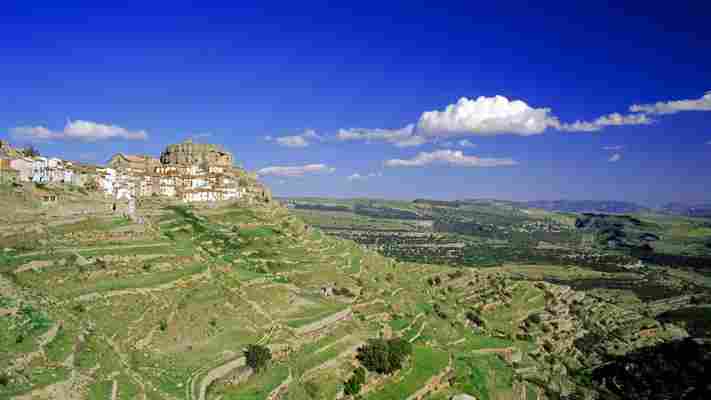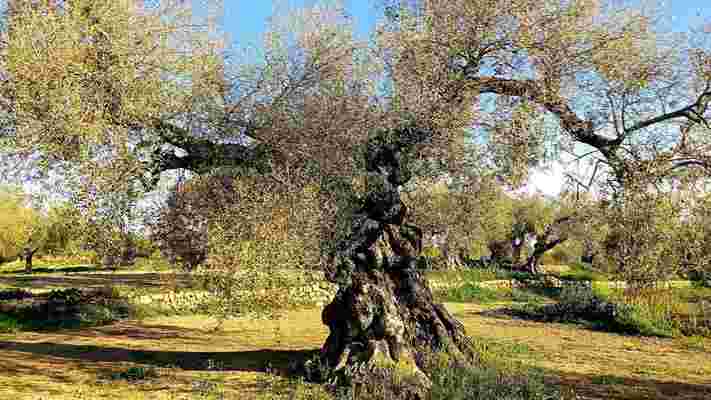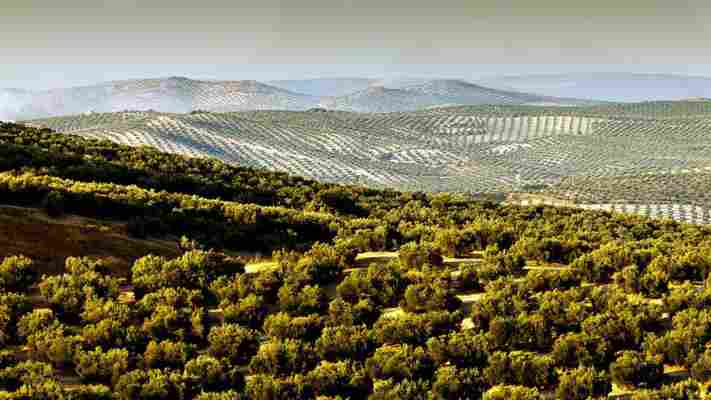Article continues below
In Castellón Province, Spain, you’ll see evidence of Roman life everywhere.
Stretches of the ancient Vía Augusta, which was the longest thoroughfare through the Iberian Peninsula during Roman rule, still survive in the region, linking remnants of bridges, arches and villas. But it’s not the excavated mansions, the mills or even the mile markers along the historic route that are most remarkable. It’s the 2,000-year-old olive trees.

Spain’s Castellón Province is home to 2,000-year-old olive trees (Credit: robertharding/Alamy)
Dotting the landscape of Castellón’s Maestrat region in the northern reaches of the Valencia Community, the trees vary in age from those that could have seen the reign of Augustus Caesar to those that bore witness to the fall of the Roman Empire ‒ and they still produce olives.
They deserved their own, special treatment.
“Thirteen of our 150 millenary trees are about 2,000 years old,” said Jose Verge Verge, the owner of Oleomile , an olive oil production company he runs with his wife, Lola Santos Ruiz. “My ancestors have been making olive oil for more than 20 generations. We have records from 1237, and three of my great-grandfathers owned mills.”
The first in the family to leave the farming business for a corporate career, Verge is now back, managing Oleomile full-time. “I wasn’t going to be the one to break the chain of this many generations,” he said with a smile. He was also the first in the family to isolate olives from trees that are more than 1,000 years old (or millenary) for separate harvest, oil extraction and bottling. ‘A living history’, as Santos put it, they deserved their own, special treatment.

Jose Verge Verge’s family has been making olive oil for 20 generations (Credit: Jose Verge Verge/Oleomile)
Because millenary trees are protected by the government, the usual harvesting procedure of shaking the trunk with the vibration harvester isn’t allowed. Instead, manual hand-held shakers are applied to branches to carefully dislodge the olives. “It takes two people two hours to harvest from two to three trees,” said Verge.
The olives are pressed on the day of the harvest to produce extra virgin olive oil. “Some experts say that the oil from millenary trees tastes sweeter,” said Verge, “because it’s more difficult for the water to rise up through the old wood [of their trunks].”
The presence of olivo silvestre (the olive tree ubiquitous to the Mediterranean Basin) in the area extends as far back as the Late Stone Age, but its cultivation didn’t begin until much later ‒ between 3700 and 3500BC.
“The domesticated tree probably arrived on the Iberian Peninsula with the Phoenicians around 11th Century BC,” said Yolanda Peña Cervantes, professor of archaeology at the National Distance Education University (UNED). Having travelled to the Iberian Peninsula from the region that today comprises Lebanon, Syria and Israel, Phoenicians traded olive oil with the local population and most likely introduced the skills required for cultivating olive trees.

Andalucia was once one of the largest exporters of olive oil to Rome, Britannia and Germania (Credit: robertharding/Alamy)
Subsequent Roman rule (between 2nd Century BC and 4th Century AD) of the peninsula brought an increase in olive oil production, and Baetica ‒ the Roman province that for the most part encompasses today’s Andalucia ‒ became one of the largest olive oil exporters to Rome, Britannia and Germania.
Unlike Baetica, Hispania Tarraconnensis, the province that included today’s Castellón, didn’t produce olive oil on an industrial scale. Archaeologists have found no evidence of the production of amphorae (the ceramic jugs used to transport oil), leading them to believe olive oil extracted in Tarraconnensis stayed there.
There are two liquids that are agreeable to the human body ‒ for the interior is wine and for the exterior is oil.
In addition to being an integral part of the diet, olive oil was used to make perfume, treat maladies, conduct religious rituals and provide lighting inside houses and temples.
“There is a saying by Pliny [the Elder],” Peña said. “He says, ‘there are two liquids that are agreeable to the human body ‒ for the interior is wine and for the exterior is oil’. The cultural value of the olive oil and olive tree is very important in the Mediterranean [at that time].”
The value of the trees has not waned. “My olive trees are my liberty,” said Ramón Mampel Dellà, president of the Clot d’en Simó Cooperative , which he started with a few others 17 years ago to ‘ dar la vuelta’ (create a change in thinking) about millenary trees among local farmers.
Olive oil from millenary trees can cost anywhere from 20 to 100 euros for 500ml (Credit: John Miller Photographer/Getty Images)
At the start of the 21st Century, a robust trade was decimating Castellón’s old trees. Because they couldn’t compete in olive oil production with Andalucía, farmers sold the trees to survive. Wealthy individuals from all over the world paid thousands of euros to uproot the trees, transport them to Madrid, Germany, Italy and beyond, and re-plant them as decoration.
“We lost about 3,000 trees,” Mampel said. “I remember the first that was sold had a 9m circumference. It could have been more than 2,000 years old.”
The Clot d’en Simó Cooperative set out to find ways to create additional value for those who owned the remaining trees as an incentive to keep them in the region. In the years that followed, Mampel and his supporters organised a separate production of olive oil from millenary trees as opposed to younger trees for members of their cooperative, published a book of photos, held several art exhibitions, and worked with the parliament of the Valencia Community to pass a law protecting the trees.
“We wanted to honour our heritage,” Mampel said. “Something we may have lost with the sale of these trees ‒ and not only from our fathers and our grandfathers but also from cultures much further away.”
Maestrat’s olive farmers sold ancient trees to buyers abroad, nearly wiping the trees out of the region (Credit: DEA/G BERENGO GARDIN/Getty)
And while many fought them because of the lucrative trade ‒ they even received threats ‒ the cooperative pressed on. In 2006, the parliament voted unanimously to ban the sale of trees older than 350 years of age.
Today, around 5,000 to 6,000 millenary trees survive and thrive in Castellón. “First we were the warriors,” Mampel said, smiling. “And now we are the guardians.”
First we were the warriors, and now we are the guardians.
Part of this guardianship is teaching people to respect the trees ‒ something Mampel hopes to achieve through tourism. With the help of Turiart , a company dedicated to cultural exploration of the area, Clot d’en Simó offers several routes that take tourists through areas populated with millenary trees.
“[The tree] is a living being,” Mampel said. “We want to teach people to respect that.”
Verge: ‘Some experts say that the oil from millenary trees tastes sweeter’ (Credit: Jose Verge Verge/Oleomile)
The olive oil pressed from millenary trees is expensive ‒ priced several times higher than regular olive oil. Verge charges 78 euros for 500ml of oil from his 1,000-year old trees; his rate for the same amount of oil from his 2,000-year-old trees varies. Other producers in the area charge anywhere from 20 to 100 euros for 500ml.
When asked how they established their prices, Mampel didn’t hesitate.
“We give the oil as a gift,” he explained, “but we charge for emotions, feelings, culture, history and heritage.”
Join over three million BBC Travel fans by liking us on Facebook , or follow us on Twitter and Instagram .
If you liked this story, sign up for the weekly bbc.com features newsletter called "If You Only Read 6 Things This Week". A handpicked selection of stories from BBC Future, Earth, Culture, Capital and Travel, delivered to your inbox every Friday.
